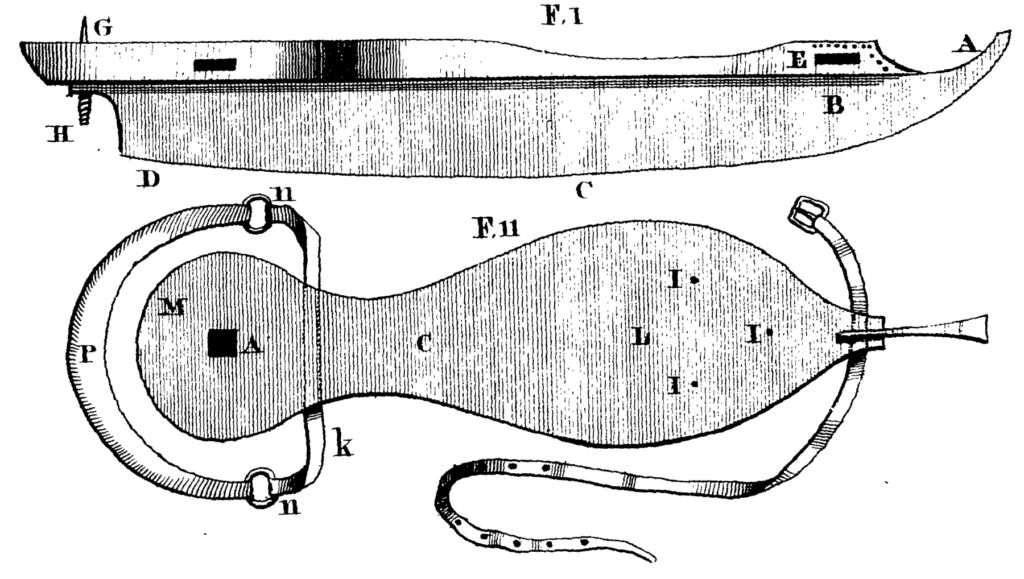In his 1772 Treatise on Skating, Robert Jones describes what he considers the ideal skate in detail, including measurements:
Figure 1 (top) represents a skate, made after the English fashion, with some improvements; the proportions are as follows: Let the distance from the point of the fender, A, to the toe hook, which is shewn by the pricked line, be one inch, and three quarters; B, the fort of the iron, whose lower surface is five sixteenths of an inch in breadth, and gradually increases to five eighths of an inch, at the point of the fender; and from B, must gradually decrease to a bare quarter of an inch, at the heel D. C, the arch where the height of the iron is one inch three eighths; at B, one inch one eighth; and at D, one inch and a quarter: the groove that is cut in the stock, to receive the upper edge of the iron, is seldom made more than a quarter of an inch deep, so that the height of the iron from the stock will be at the arch one inch and one eighth, which is high enough for any sort of skating. E, the toe strap hole; F, the under strap hole; each of these holes must be cut so that the straps may go in very tight. G, the heel peg, whose diameter at bottom is a quarter of an inch, and at top one eighth; its height is determined by the heel of the shoe with which it is to be worn, but is seldom less than half an inch. H, the heel screw, which should always be made short.
Figure 1 (bottom) is a plan of a skate compleat, with straps, &c. M, the heel of the stock, whose diameter is two inches and three eighths. G, the waist, whose diameter is one inch one eighth. L, the tread, which is two inches and seven eighths in breadth. The thickness of the stock is three quarters of an inch; but the surface of the tread must be depressed a quarter of an inch, that the ball of the foot may rest easy.
I. I. I. are little sharp points of iron, each of which projects from the stock about one eighth of an inch; the distance from the centre of the under strap hole, to the extremity of the heel, is two inches and a half; and from the centre of the heel peg, A, to the extremity of the heel, one inch one eighth; K, the under strap; P, the heel strap, N. N. rings to which the straps are sewed; the length of the under strap from ring to ring is five inches and a half, and the heel strap seven inches; the length of the toe strap is determined by the size of the
foot, but it must always sit very tight in the stock.N. B. These proportions are for a middle-sized foot.
Jones 2017 [1772], 34–37
He even includes a diagram:

Jones’ detailed description doesn’t answer some rather burning questions, such as “how far toward the front did the skater’s shoe go?”. I also wonder what “improvements” he included and whether skates that incorporated them were ever actually made.
Henry Raeburn’s painting The Reverend Robert Walker Skating on Duddingston Loch, painted in the 1790s, can help with some of this. Walker’s skates appear quite similar to the ones Jones recommends.

It seems to have a clamp at the heel instead of a screw, and the rear lacing hole seems to be doubled and under the instep—a bit farther forward than Jones put it. It does show that the skater’s toes come all the way to the front of the wooden footbed and highlights one possible lacing pattern, which is shown from a different angle on the other foot.
Sybolt Woudenberg owns a pair of skates that are similar to these. In Kouwe Drukte, they’re compared with Robert Walker’s skates, but from the heel screw and position of the rear hole, they look a bit more like Jones’s. However, they do have an extra hole under the instep, like Walker’s skates. Maybe Jones forgot to include that? And the toes seem to curl up farther without flaring out like Jones’ do.
References
Robert Jones. 2017 (1772). A Treatise on Skating. Edited by B. A. Thurber. Evanston, IL: Skating History Press.
Sybolt Woudenberg. 2013. “Paar van de dominee?” Kouwe Drukte 17 (49): 6.
